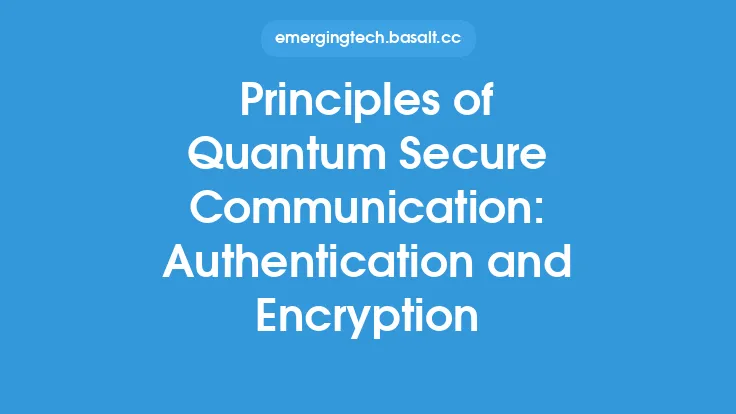The concept of secure communication has been a cornerstone of human interaction, from ancient messengers to modern-day digital transactions. As technology advances, the need for secure communication has become increasingly important, and quantum key distribution (QKD) has emerged as a promising solution. QKD is a method of secure communication that uses quantum mechanics to encode and decode messages, providing a virtually unbreakable level of security.
What is Quantum Key Distribution?
Quantum key distribution is a technique that enables two parties to securely exchange cryptographic keys over an insecure communication channel. This is achieved by using quantum mechanics to encode the keys onto photons, which are then transmitted over the channel. The security of QKD relies on the principles of quantum mechanics, specifically the no-cloning theorem and the Heisenberg uncertainty principle. The no-cloning theorem states that it is impossible to create a perfect copy of an arbitrary quantum state, while the Heisenberg uncertainty principle states that it is impossible to measure certain properties of a quantum system, such as position and momentum, simultaneously with infinite precision.
How Does Quantum Key Distribution Work?
The QKD process involves several steps. First, two parties, traditionally referred to as Alice and Bob, agree on a protocol for secure communication. Alice then encodes a random sequence of bits onto photons, using a technique such as polarization or phase encoding. The encoded photons are transmitted over the insecure communication channel to Bob, who measures the photons to decode the sequence of bits. The security of the transmission is ensured by the fact that any attempt to measure the photons by an eavesdropper, Eve, would introduce errors into the sequence of bits, making it detectable.
Quantum Key Distribution Protocols
There are several QKD protocols that have been developed, each with its own advantages and disadvantages. Some of the most well-known protocols include:
- BB84: This is one of the earliest and most widely used QKD protocols. It uses four non-orthogonal states to encode the bits, and is secure against individual attacks.
- Ekert91: This protocol uses entangled photons to encode the bits, and is secure against collective attacks.
- Differential phase shift quantum key distribution (DPS-QKD): This protocol uses a differential phase shift to encode the bits, and is secure against individual attacks.
Security Proofs
The security of QKD has been extensively studied, and several security proofs have been developed. These proofs demonstrate that QKD is secure against various types of attacks, including individual attacks, collective attacks, and coherent attacks. The security proofs are based on the principles of quantum mechanics, and rely on the fact that any attempt to measure the photons would introduce errors into the sequence of bits.
Implementation and Challenges
While QKD has been demonstrated in several experiments and has been implemented in some commercial systems, there are still several challenges that need to be addressed before it can be widely adopted. Some of the challenges include:
- Distance: QKD signals are attenuated over long distances, which limits the range of secure communication.
- Interoperability: Different QKD systems may not be compatible with each other, which can limit their use.
- Cost: QKD systems are currently more expensive than classical encryption systems.
- Scalability: QKD systems need to be scalable to support a large number of users.
Applications and Future Directions
Despite the challenges, QKD has several potential applications, including:
- Secure communication networks: QKD can be used to secure communication networks, such as financial transactions and sensitive government communications.
- Cloud computing: QKD can be used to secure data in cloud computing, where data is stored and processed remotely.
- Internet of Things (IoT): QKD can be used to secure communication between devices in the IoT.
In conclusion, quantum key distribution is a promising technique for secure communication that uses quantum mechanics to encode and decode messages. While there are still several challenges that need to be addressed, QKD has the potential to provide a virtually unbreakable level of security, and its applications are expected to grow in the coming years.
Real-World Implementations
Several companies and organizations are already working on implementing QKD in real-world scenarios. For example, the Chinese government has implemented a QKD-based secure communication network between Beijing and Shanghai, while the European Union has launched a project to develop a QKD-based secure communication network across the continent. Additionally, several companies, such as ID Quantique and MagiQ Technologies, are offering QKD-based products and services.
Theoretical Advances
Researchers are also working on advancing the theoretical foundations of QKD. For example, new protocols such as measurement-device-independent QKD (MDI-QKD) and twin-field QKD (TF-QKD) have been developed, which can improve the security and range of QKD. Additionally, researchers are exploring new techniques such as quantum machine learning and quantum error correction, which can be used to improve the performance and reliability of QKD systems.
Conclusion
In summary, quantum key distribution is a powerful technique for secure communication that uses quantum mechanics to encode and decode messages. While there are still several challenges that need to be addressed, QKD has the potential to provide a virtually unbreakable level of security, and its applications are expected to grow in the coming years. As researchers and companies continue to advance the theoretical foundations and practical implementations of QKD, we can expect to see widespread adoption of this technology in the near future.





